Super Smash Bros. Ultimate: Difference between revisions
(→Trivia: How come this hasn't been pointed out? Ultimate has more returning stages than new ones, even if we were to count the five DLC stages (assuming all are gonna be new). The no music in the commercial is absurd even for a trivia.) |
Aidanzapunk (talk | contribs) m (Melee) |
||
| Line 270: | Line 270: | ||
**Feature [[Sonic (universe)|third-party]] [[Mega Man (universe)|universes]] with more than one Assist Trophy. | **Feature [[Sonic (universe)|third-party]] [[Mega Man (universe)|universes]] with more than one Assist Trophy. | ||
**Have an Assist Trophy character originating from an [[Shovel Knight (universe)|indie game]]. | **Have an Assist Trophy character originating from an [[Shovel Knight (universe)|indie game]]. | ||
**Not introduce a new type for a playable Pokémon (as both [[Charizard|Fire]] and [[Greninja|Dark]] were used in previous games). | **Not introduce a new type for a playable Pokémon (as both [[Charizard|Fire]] and [[Greninja|Dark]] were used in previous games). | ||
**Have a [[Lifelight|theme song]] in both English and Japanese. | **Have a [[Lifelight|theme song]] in both English and Japanese. | ||
Revision as of 15:27, November 13, 2018
- "SSBU" redirects here. For the Wii U version of Super Smash Bros. 4, see Super Smash Bros. for Wii U.
- For the team, see Team:Super Smash Bros. University.
| Super Smash Bros. Ultimate | |
|---|---|
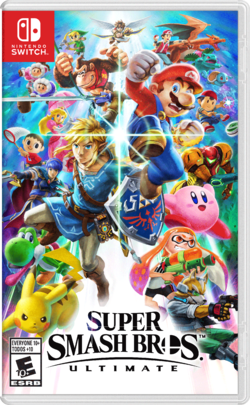 North American box art. | |
| Developer(s) | Bandai Namco Sora Ltd. |
| Publisher(s) | Nintendo |
| Designer(s) | Masahiro Sakurai |
| Projected release date | December 7, 2018 |
| Genre(s) | Fighting Platforming |
| Ratings | CERO: A ESRB: E10+ OFLC: PG PEGI: 12 USK: 12 |
| Media | ROM Cartridge Digital distribution (Nintendo eShop) |
| Input methods | Joy-Con, Nintendo Switch Pro Controller, GameCube controller (via adapter) |
Super Smash Bros. Ultimate (大乱闘スマッシュブラザーズ SPECIAL, Great Fray Smash Brothers Special) is an upcoming fighting game for the Nintendo Switch. It was first announced on March 8th, 2018 at the end of the Nintendo Direct released the same day. It will be the fifth installment in the Super Smash Bros. series (sixth if both versions of Super Smash Bros. 4 are counted as two games). The game is scheduled to release on December 7, 2018.
Reveal and promotion
A first teaser trailer at the end of a Nintendo Direct presentation on March 8th, 2018 revealed that a new Super Smash Bros. title was in development for the Nintendo Switch, planned for release before the end of 2018. Without explicitly confirming the playable status of any characters, the teaser trailer hinted the Inklings would be debuting in the game as newcomers, while also suggesting that Mario, Link, and several other series veterans would be returning.
The first extended look at the game came at Nintendo's E3 2018 presentation. Series creator and game director Masahiro Sakurai introduced the coverage, which kicked off with an extended video showing new incarnations for veteran characters. After confirming the return of previously cut characters such as Ice Climbers and Snake, the tagline "Everyone Is Here" was introduced, and the video revealed that all playable characters from previous Smash Bros. titles would be returning to the new game, including the formerly cut Ice Climbers, Pichu, and Young Link from Melee, as well as Pokémon Trainer, Wolf, and Snake from Brawl. The trailer also confirmed the Inklings as the game's first newcomers, while concluding with a reveal of the game's final title: Super Smash Bros. Ultimate.
Later in the E3 presentation, new information on the Ultimate incarnations of characters was revealed, including the presence of Cappy in Mario's taunts and other moves, that Zelda would be based on her Link to the Past design, all the DLC fighters from Smash 4 would return as part of the launch roster, Ike would have his Path of Radiance and Radiant Dawn designs from the two previous games and much more. The presentation introduced "Echo Fighters", which Lucina and Dark Pit are now marked as, while Daisy was revealed as a new Echo Fighter. The presentation also confirmed returning elements, items, and stages, which would receive revamped Ω forms and Battlefield forms. The presentation concluded with a final trailer in which Ridley from Metroid - long requested by fans for inclusion in the series but rebuffed by Sakurai due to his large size - finally "hits the big time" as he joined the roster of playable characters as a newcomer.
At the EVO 2018 fighting game tournament, Nintendo revealed that a new Ultimate-focused Nintendo Direct presentation would be released on August 8, 2018. The presentation opened with a trailer confirming the inclusion of content from Konami's Castlevania franchise for the first time in the series. The trailer revealed the presence of new fighters, Simon Belmont and his Echo Fighter, Richter Belmont; a new Assist Trophy, Alucard; a new stage called Dracula's Castle, and more. The Direct also covered two new Echo Fighters, Chrom and Dark Samus, as well as new music, modes, stages, and items. The presentation concluded with a trailer introducing a new playable character: King K. Rool, leader of the Kremlings and nemesis of the Kong family from the Donkey Kong and Donkey Kong Country series.
In a Nintendo Direct presentation shown on September 13th, 2018, a Super Smash Bros. Ultimate Nintendo Switch console bundle was unveiled, featuring a specially designed dock and Joy-Con controllers. Isabelle, from the Animal Crossing series was also revealed as a newcomer.
The final pre-release Ultimate-focused Nintendo Direct presentation aired on November 1, 2018. This revealed Ken and Incineroar as new playable characters, as well as the inclusion of DLC fighters - Piranha Plant appearing shortly after launch, followed by five other unannounced characters, which have been selected in advance by Nintendo as future additions, and have yet to be developed.[1] It also took a deeper look at the game's modes and online infrastructure, and revealed Spirits mode and Adventure Mode: World of Light, before finishing with the mode's opening cutscene and the reveal of the game's vocal theme, Lifelight.
After the game's reveal, an official site and information blog was launched as an official platform to provide information on the game. Available in a variety of languages, the site is continually updated to provide details on new and returning fighters, stages, items, music, and other Ultimate-related information.
Confirmed elements
Characters
All 63 characters (65 if counting the Pokémon Trainer's Pokémon) from all previous Smash Bros. games return as playable characters. As well as the returning cast, 11 newcomers have been confirmed as of November 1st, 2018, with at least six characters (one known and five unknown) planned as downloadable content. In total, this ensures that at least 74 characters (76 if counting the Pokémon Trainer's Pokémon) are playable in the game at launch and 80 (82) characters are playable overall, the most for any Smash Bros. game. Each character is numbered in the order from when they first joined the series.
Inkling, with various Girl and Boy designs from the original Splatoon, was the first character confirmed to appear in the game as a playable character. Ridley, a central villain from the Metroid series, is also confirmed to be playable, with Meta Ridley as an alternate costume. King K. Rool, arch-rival of Donkey Kong and Diddy Kong from the Donkey Kong series, is confirmed to be a playable newcomer as well, with his move-set drawing on his appearances as a boss in the Donkey Kong Country games onward. Isabelle from the Animal Crossing series, who previously appeared in Smash 4 as an Assist Trophy, makes her playable debut as the second Animal Crossing representative. Finally, in the November Direct, Incineroar from Pokémon Sun & Moon was announced as the title's last base roster newcomer.
Simon of the Castlevania series has been announced as the game's first third-party newcomer, while Piranha Plant from the Mario series has been announced as the game's first DLC character.
Playable clone characters are now described as "Echo Fighters" and are marked with an epsilon symbol (ε). Returning characters Dark Pit and Lucina have been retroactively given this title, while new characters Daisy, Richter, Dark Samus, Chrom, and Ken are confirmed to be Echo Fighters of Peach, Simon, Samus, Roy, and Ryu, respectively. The character select screen in Ultimate will give players the option to display Echo Fighters in their own character slots, or to stack Echo Fighters with the character they are based on together in a single slot.
Only the starting characters from the first game are available from the start, however, the Mii Fighters' availability is still not known. The rest of the roster needs to be unlocked, however the unlocking process is going to be faster and easier compared to previous games.
| Veterans (65) | |||||||||||||||
|---|---|---|---|---|---|---|---|---|---|---|---|---|---|---|---|
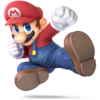 Mario |
 Luigi |
 Peach |
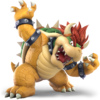 Bowser |
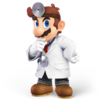 Dr. Mario |
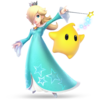 Rosalina & Luma |
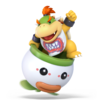 Bowser Jr. |
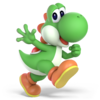 Yoshi | ||||||||
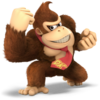 Donkey Kong |
 Diddy Kong |
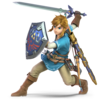 Link |
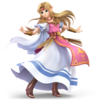 Zelda |
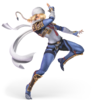 Sheik |
 Ganondorf |
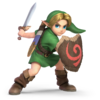 Young Link |
 Toon Link | ||||||||
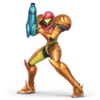 Samus |
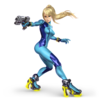 Zero Suit Samus |
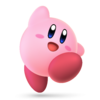 Kirby |
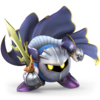 Meta Knight |
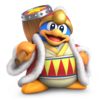 King Dedede |
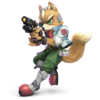 Fox |
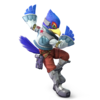 Falco |
 Wolf | ||||||||
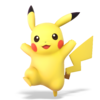 Pikachu |
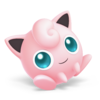 Jigglypuff |
 Mewtwo |
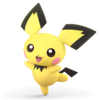 Pichu |
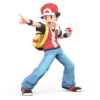  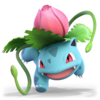 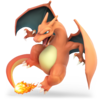 Pokémon Trainer (Squirtle, Ivysaur, Charizard) | |||||||||||
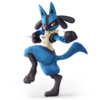 Lucario |
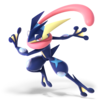 Greninja |
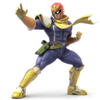 Captain Falcon |
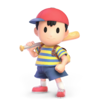 Ness |
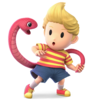 Lucas |
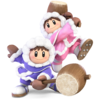 Ice Climbers |
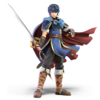 Marth |
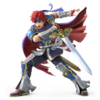 Roy | ||||||||
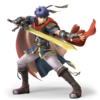 Ike |
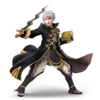 Robin |
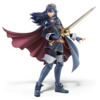 Lucinaε |
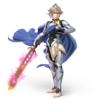 Corrin |
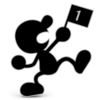 Mr. Game & Watch |
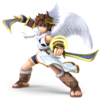 Pit |
 Palutena |
 Dark Pitε | ||||||||
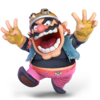 Wario |
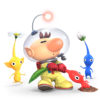 Olimar |
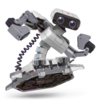 R.O.B. |
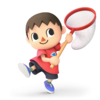 Villager |
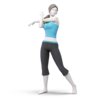 Wii Fit Trainer |
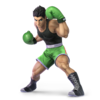 Little Mac |
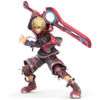 Shulk |
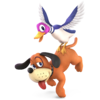 Duck Hunt | ||||||||
 Snake |
 Sonic |
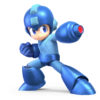 Mega Man |
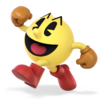 Pac-Man |
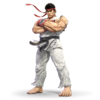 Ryu |
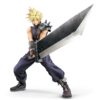 Cloud |
 Bayonetta |
|||||||||
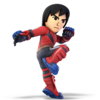 Mii Brawler |
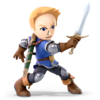 Mii Swordfighter |
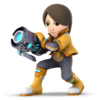 Mii Gunner |
|||||||||||||
| Newcomers (24) | |||||||||||||||
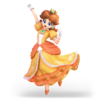 Daisyε |
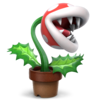 Piranha Plant (DLC) |
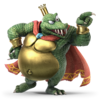 King K. Rool |
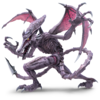 Ridley |
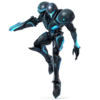 Dark Samusε |
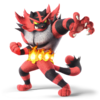 Incineroar |
 Chromε |
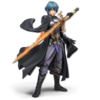 Byleth (DLC) | ||||||||
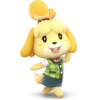 Isabelle |
  Pyra/Mythra (DLC) |
 Inkling |
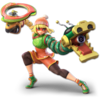 Min Min (DLC) |
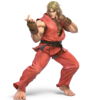 Kenε |
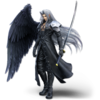 Sephiroth (DLC) |
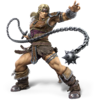 Simon | |||||||||
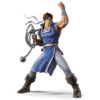 Richterε |
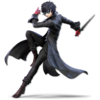 Joker (DLC) |
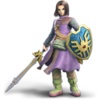 Hero (DLC) |
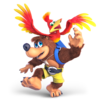 Banjo & Kazooie (DLC) |
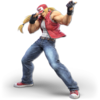 Terry (DLC) |
 Steve (DLC) |
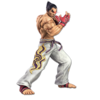 Kazuya (DLC) |
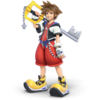 Sora (DLC) | ||||||||
Bold denotes starter characters.
"ε" denotes Echo Fighters.
Bosses
Stages
With the exception of the Super Smash Bros.-original stages, all stages are ordered in chronological appearance and for the first time ever, all stages are available immediately from boot-up. It was also stated that all stages can be played with up to 8 players. All stages have both a Battlefield form and Ω form. Ultimate will feature 103 stages at launch. An additional 5 planned stages will be added to the game via downloadable content, which will bring the amount of stages up to 108.
New Items
- For the entire confirmed list of items, see Items page.
| Item | Type[2] | Heavy[2] | Notes | Universe |
|---|---|---|---|---|
| Banana Gun | Shooting | Ejects the banana out of the peel and the player is left with the banana peel after using it. | ||
| Beastball | Throwing | Reappears near an opponent after being thrown and targets them, covered in flames. | ||
| Black Hole | Throwing | Creates a massive black hole, dragging all items and players nearby in. Throws the opposite side of user's orientation. | ||
| Bomber | Special | Explodes in the player's hand when used, which only affects enemies. Will also explode after a short amount of time or if it falls off a ledge, affecting everyone. | ||
| Death's Scythe | Battering | Instantly KOs opponents at high percentages. | ||
| Fake Smash Ball | Special | Flies around the stage, similar to the Smash Ball. Characters can break it in order to activate. Once broken, it will explode. | ||
| Healing Field | Throwing/Recovery | Can be thrown on the ground. Once thrown, it will open up and will heal anyone standing on it. | ||
| Healing Sprout | Throwing/Recovery | Sticks to fighters and gradually heals them. Can be transferred on contact like the Gooey Bomb. | ||
| Killing Edge | Battering | Will occasionally glow, causing it to do more damage. | ||
| Rage Blaster | Shooting | Does more damage the higher the user's damage is. | ||
| Ramblin' Evil Mushroom | Shooting | Emits spores that, when they hit an opponent, cause a mushroom to grow on that opponent's head, reversing their controls. | ||
| Staff | Shooting | Fires a laser which deals increased damage the greater its distance from the user. | ||
| Super Launch Star | Throwing | Can be set in midair, where it will attract and launch any characters that get too close to it. The launch has the potential to KO fighters. |
Development
Towards the end of Super Smash Bros. 4's post-launch development, Masahiro Sakurai announced that his next project had been decided and that he would be taking a small vacation following the end of development.[3] Unlike previous Smash titles, which had their development studios built from the ground up, Bandai Namco returned to help game development. Prior to starting development, the team had a choice between completely overhauling the game's system and feel or working off of what was established in the last game. The team ultimately went with the latter. Had the team gone with the former, the game would have likely only had a third of its characters.[4] Despite deciding to base the game off of the previous installment, Sakurai still increased the overall speed of the game, but only by an amount that wouldn't be too alienating to people unfamiliar with the series.[4] Sakurai notes that he had wanted to make these changes in previous titles, but was unable to because it was easy for one to lose track of their character's position on screen, especially on the Nintendo 3DS.[4] When Sakurai had revealed to his development team that he intended to bring back every previously playable character, he was met with silence.[5] Prior to leaving Bandai Namco, presumably sometime in 2016, Tiago Sonobe, then a software engineer and graphics programmer for the company, started development on the game's rendering engine. On November 12th, 2017, Nintendo filed a number of trademarks, notably including a Japanese Super Smash Bros. logo.[6]
A Super Smash Bros. title for the Switch was later officially revealed on March 8th, 2018 via a Nintendo Direct. Shortly after, Sakurai confirmed in a tweet that he had been working on the game "in silence, day after day".[7][8] On March 22nd, 2018, Nintendo announced the Super Smash Bros. Invitational 2018, a tournament taking place on June 12th where invited professional players will play the upcoming game. Later, in volume 542 of his Famitsu article, Sakurai revealed that his work schedule had been cut down significantly, citing strict regulations regarding work hours.[9] On April 18th, 2018, Nintendo again filed a number of trademarks for several game logos, including the Super Smash Bros. logo. Most of these game logos originate from games with some relationship to the Smash series, including Pikmin, Star Fox, and F-Zero. These trademarks were approved on May 14th, 2018.[10]
The game was finally unveiled at E3 2018 via a Nintendo Direct. The 25-minute trailer featured in the Nintendo Direct confirmed the title of the game as Super Smash Bros. Ultimate, revealed that every previously playable character would return, with Daisy and Ridley as new playable characters, and showcased new and returning gameplay features. Following the end of the presentation, a Nintendo Treehouse event went live. During the Treehouse event, several matches were streamed and some new features were revealed and discussed. In addition to the Treehouse livestream, a playable demo of the game was opened to the public at E3 2018 and at the Nintendo Store in New York. Following the end of the Splatoon 2 World Championships, the Super Smash Bros. Invitational 2018 began. During the match pitting MkLeo as Bayonetta against Plup as Ridley, Masahiro Sakurai reportedly shook his head after MkLeo had performed a successful ladder combo on Plup.[11] At the end of the invitational, the Nintendo Treehouse livestream resumed, further showcasing more gameplay elements and matches. In addition to this, the official Super Smash Bros. Ultimate website was published. This would serve as the primary source for new details about the game.
A demo of the game would later be playable at certain tournaments and events in Japan and the United States, including Rage 2018 Summer, Next Generation World Hobby Fair ’18 Summer, CEO 2018, Jump Victory Carnival 2018, and EVO 2018, along with events in other countries such as FestiGame Chile 2018, and Insomnia 64 in the United Kingdom.
Changes from SSB4
As Super Smash Bros. Ultimate is still in development, the information listed below has been taken from the E3 Demo version and gameplay trailers and may be subject to change after the official release of the game.
Menu and UI changes
- In Vs. mode, the stage selection screen now appears before the character selection menu, making players select a stage before selecting characters.
- The rule selection screen appears before the stage selection screen.
- All stages now have a Battlefield form. Ω forms are also standardized to have the same underside shape akin to Final Destination, with none of them having vertical walls.
- Stage hazards can be turned off for the first time in the series, allowing players to remove intrusive elements, such as "environment changes or enemy appearances" from gameplay. What constitutes as a "hazard" is not yet clear, but seems to include even mild elements such as tilting or platform movement.
- The new Stage Morph option allows two stages to be selected at once; the two stages will transition into one another either at random or on specified time intervals.
- Alternate costumes are now shown at the bottom of the player's portrait, with at least eight small stock icons representing each palette swap. Additionally, each color is now listed with a name from the numbers 1-8 (e.g. Color 5).
- In timed matches, characters in the lead will occasionally flash with a gold sparkle.
- While a match is loading, an intense versus splash screen will appear, showing the combatants in their CSS renders and alternate costume. Tips will sometimes show up.
- The damage meter now displays tenths of a damage percentage (e.g. 10.5%). Note that while all games since Melee have used decimal percentages, this is the first game to reveal that fact instead of simply rounding down for display.
- In one-on-one stock fights, the stock count of both fighters will be briefly displayed onscreen whenever a stock is lost.
- The character select screen is now similar in appearance to the original Super Smash Bros. 64 menu when starting the game, with the other fighters unlocked later on.
- While a fighter is knocked off the stage, a minimap which shows the character locations, blast zone, and camera zoom will appear on the corner of the screen.
- The closer a fighter is to a blast zone, the smaller their "magnifying glass" camera becomes. It will start flashing when they are almost touching the blast line.
- Like Little Mac's Power Meter in Smash 4, several characters now sport additional UI elements next to their damage meter, such as Villager's Pocketed item, Robin's durability counters, or Inkling's Ink Tank gauge.
- Stages that once shared names now have been renamed. For example, the Smash 64 version of Yoshi's Island is now Super Happy Tree and the Brawl version of Mario Circuit is now Figure-8 Circuit.
- Tracks in My Music are now organized by series rather than by stage, such that all music from a given series will be available across the stages corresponding to that series.
- Sound Test can be used to create music playlists, which can be played in handheld mode while the screen is off like a music player.
- Two new battle modes are present:
- Squad Strike begins with two sides each choosing a set of three or five fighters, then battling with them in one of two ways:
- A two-player battle where each player uses their set of fighters within a single 1-on-1 match.
- A "crew battle" mode with two teams of players, each of whom brings one fighter from the set into 1-on-1 battle.
- Smashdown renders the fighters selected in a given battle unavailable for use in following battles, forcing players to select a different fighter with every match they play.
- Squad Strike begins with two sides each choosing a set of three or five fighters, then battling with them in one of two ways:
- Echo Fighters can either be displayed in their own character slots, or share their slot with the character they are based on, depending on user preference.
- The main text font from Melee, Brawl and SSB4 does not appear to be used anymore.
Gameplay changes
- To increase gameplay speed, all damage taken in one-on-one fights with no items is multiplied by 1.2×.
- Short hop aerial attacks now have a damage multiplier of 0.85×. This is presumably to offset the aforementioned 1.2× damage increase.
- While knockback itself might be unchanged, the physics of launch movement are different from all previous games — characters have a much higher initial speed and deceleration, resulting in being launched at very high speeds yet slowing down to nothing very quickly. This new knockback behavior has been likened to hitting a balloon.
- Rage only becomes noticeable with damages of 120% or above, and its knockback increase has been toned down.
- Perfect shields are performed in reverse: instead of pressing the shield button several frames before an attack connects, players have to release the shield button when an attack connects on their shield instead. This also causes the screen to pause briefly, with the fighter's eyes flashing to signify a perfect shield, and no shield damage being taken as a result. This updated mechanic makes perfect shielding a much riskier tactic, but allows a perfect-shielding fighter to retaliate much faster against attacks when successful.
- It now takes 11 frames to shield drop, making the game less defense-focused.[12]
- Hitting a shield now contributes to staling.
- If two grabs collide, both characters take minimal damage and act as if grab released. This removes the effect of port priority in determining who gets the grab.
- Edge sweet spots have become smaller, and recovery moves take longer to snap on ledges in general. This makes recovering riskier.
- Footstools have been nerfed, with opponents being able to tech on the ground during the footstool animation.
- Reeling can be teched on the ground, like in previous Smash games.
- Meteor smash attacks can no longer be teched when grounded, regardless of their electric properties.
- Locks can now only be performed twice in a row.
- Characters can no longer run through shielding characters and instead push them backwards, preventing cross-ups or mixups revolving around moving through an opponent. This also seems to affect several momentum-based moves, which now stop on shield (such as Fox Illusion and Heel Slide).
- Screen KOs are much faster, making them once again faster than Star KOs.
- Sudden Death consists of the screen slowly zooming in, making the blast zones gradually shrink. It also appears to have a fixed camera angle, and the screen progressively gets covered in aesthetic flames, starting with the corners. If the screen has finished zooming in, Bob-ombs will start falling after a while.
- Timed battles can last 2 and a half minutes, which signifies more precise time limit options for versus mode.
- Stamina battles are now part of the basic rule selection, allowing for combinations such as stamina with stocks.
- The Final Smash Meter is a new Rules option that enables fighters to charge up their Final Smash over time for use without a Smash Ball. When this option is turned on, a gauge will appear under each fighter's damage display. The more damage the player takes, the more the meter is filled. When it is filled, the player can use a weaker version of their Final Smash.
Mobility changes
- The jumpsquat timing of every character has been standardized to 3 frames.
- Full hops and midair jumps are sped up across the cast. However, this does not apply to extra midair jumps (such as Kirby's or Pit's).
- Landing lag for aerials and helplessness has been significantly reduced overall. For some moves, the landing lag is even less than in Melee with L-canceling.
- Rolling and sidestepping repeatedly now penalizes the user with increased startup and ending lag and less intangibility frames, leaving them more vulnerable.
- Backward rolls have more ending lag overall, hindering their utility further for retreating safely and making them practically different from forward rolls again, while sidesteps conversely have less ending lag overall.
- Perfect pivoting can no longer be performed, as characters no longer enter their standing animation when turning around out of their initial dash.
- Air dodges now contain elements from all previous incarnations of the technique: airdodging to the left and right grants fighters a quick momentum boost in said direction like in Melee, but without making them helpless. However, fighters can only air dodge once before landing or getting hit, and the directional version has roughly a full second of ending lag. Additionally, standard air dodges have more ending lag and incur noticeably less landing lag.
- Wavedashing has made a return from Melee, but has been nerfed due to the new mechanics added to directional air dodging as well as increased landing lag. Techniques associated with wavedashing, like wavelanding, are also back, but to what extent is unclear.
- Initial dashes seem to have been lengthened, allowing some aspects of dash-dancing to return.
- Being sent into hitstun by any attack from behind will preserve the direction the character is facing, like with Back Slash in Smash 4, having the effect of preserving the positions of their forward and back aerials.
- As a result, all characters now have unique hitstun animations for taking hits from behind.
Attack changes
- Characters can now perform any ground attack out of a run, including their neutral attack, tilt attacks, and all smash attacks. In previous games, only dash attacks, up smashes and special moves could be performed out of a run. Characters can also instantly turn around to input any grounded attack in the other direction.
- Short hop aerial attacks can be performed by pressing the jump and attack buttons at the same time.
- Rapid jab neutral attacks no longer push the user off edges when hitting opponents.
- Rapid jabs now drag opponents to the ground, making them more reliable.
- Smash attacks can be charged about three times longer than previous games. Unlike in previous games, the damage increase from charging caps after a set period, but knockback continues to increase until the move is unleashed.
- Aerial attacks can be performed while hanging onto a ladder, a property known officially as a "ladder attack".
- All variations of regular grabs have more ending lag, making them easier to punish if missed. Conversely, extended grabs have less ending lag, no longer leaving characters as vulnerable compared to regular grabs.
- Pummels have been universally sped up, but deal less damage.
- Edge attacks have been buffed, now granting intangibility until the hitboxes cease rather than until 2 frames before the hitboxes come out, allowing them to beat out opposing attacks.
- Most chargeable neutral specials that can't be stored are now reversable, whether for the duration of the charge or right before they are unleashed.
- Taunts can now be canceled, and are performed much faster.
- The effectiveness of every tether recovery has been nerfed, as they cannot be performed out of air dodges quickly, brought on by increased lag, and the amount of getup is the same as regular up specials.
- Final Smashes are quicker, with versions granting a controllable transformation being removed, so players can return to fighting quickly. As a result, many fighters receive new Final Smashes or have returning Final Smashes with altered functionalities, such as Landmaster being replaced by an Arwing cutscene, and Octopus dragging opponents offstage immediately after transforming.
Aesthetic changes
- The particle effects of the game are significantly more cartoony, with a solid-color or cel-shaded aesthetic. Compared to Smash 4, hits are signified by spark-like blows instead of colorful stars, while attack effects appear visually longer-lasting or possess far larger particle effects.
- Most returning fighters feature a more subdued color scheme, but with slightly more detail in their models than from previous games.
- Time slows down substantially and the camera zooms in with a colorful blue background at significant moments during a match, such as when landing a highly damaging special move (such as a fully charged Giant Punch) or when breaking a shield. The camera also does this for potential final hits of a match, dramatically pausing gameplay with intense sound effects and red lightning/background, while zooming in. These are referred to as "Special zoom" and "Finish zoom" by Masahiro Sakurai and the development team.
- Special zoom is signified by a sound similar to landing a KO Uppercut or Finishing Touch, and finish zoom has SFX somewhat akin to the ping sound.
- Punching and kicking SFX on hit are different and sound harder-hitting compared to the previous game, with even weaker attacks playing loud "punch" effects.
- Fighters sent flying now leave a colorful, lingering trail of solid-colored smoke behind them. If dealt enough knockback, they will also play a whistling sound while flying, akin to a jet plane.
- Grab immunity after a character is thrown or released from a grab is visually indicated by their model flashing yellow until it wears off.
- Blast KOs cause a burst of confetti on the screen alongside the standard colorful blast.
- Star KO'd characters now use a tumbling animation similar to Brawl's Screen KOs, rolling away from the screen as they fly away.
- Final Smashes now cause a segment of the screen to show the upper portion of the summoner's face (or in Mr. Game & Watch's case, the close up is of where his eyes would be), which is taken entirely from the summoner's official artwork, before the move begins, similar to Chrom's appearance in Pair Up.
- Any characters standing too close to a Final Smash will visibly react to it.
- While on Final Smash standby, the character's damage gauge will constantly spark with aqua-colored electricity. Upon use, one of the eyes on the fighter's character portrait will flash.
- While rage is in effect, smoke will constantly come out of the damage meter.
- Many Assist Trophies and Final Smashes now affect the background of the stage.
- On the results screen, the announcer now says "(Character name/Team color) wins!" ("(Character name/Team color) win!" in the Japanese version), instead of saying "The winner is... (character name/team color)!" (Brawl and Smash 4} or "This game's winner is... (character name/team color)!" (Melee). Additionally, after Team Battles, all teammates will perform their complete victory animation instead of only the player with the highest score/stock count, much like the first three installments.
- In Smash 64, the announcer did say "(Team color) wins!", but this was changed in Melee.
- In addition to some characters with a mirrored stance, some Assist Trophies and Poké Ball Pokémon face the screen regardless of the direction they turn towards.
- Names now override some instances of character names, such as underneath the damage meter.
- If the player enters a name, any Poké Ball Pokémon or Assist Trophy character summoned by the player will be indicated by the player's name.
- Reflection moves now display shining hexagon effects, similar to Fox's and Falco's Reflector, upon reflecting projectiles.
Item changes
- Certain types of items, such as Banana Peels, can now be picked up by tilt attacks.
- There can now be more than one Assist Trophy active at any given time. Additionally, some characters summoned by an Assist Trophy can be KO'd, granting a point to whoever KO'd said character. If multiple players summon an Assist Trophy each, they will proceed to fight one another if close enough.
- When an Assist Trophy or Poké Ball is used at the edge of a stage or ledge, they no longer immediately fall off the stage/ledge.
- Fake Smash Balls were introduced, with inverted lines as their design. When broken, these explode into a colorful X-shaped explosion, causing heavy knockback and damage to nearby fighters. Unlike the standard Smash Ball, Fake Smash Balls tend to drift towards players and general action instead.
- Smash Balls and Fake Smash Balls have a chance of spawning with Soccer Ball physics, rolling around the stage and respawning once they drop offstage. These despawn after a set time.
- The Boss Galaga causes a black background to cover the screen when it catches an opponent, complete with pixel stars. Additionally, if the Boss Galaga Star KOs a character, it can now be seen with the character in the distance. The star also becomes larger.
- The Hammer and Golden Hammer have a unique 8-bit-styled hit particle, resembling the particle effect used when Mario destroys a barrel in the original Donkey Kong. The corresponding sound effect is also taken from the original game.
- The Warp Star's descent can now be stalled by the user.
- The Timer now creates a dark warping background alongside its usual slowdown effect.
- Blast Boxes now explode after some time if hit. This is signified by a dull orange flash around the box that slowly gets brighter.
- Trophies have been dropped in favor of Spirits, which function and visually appear to be similar to Brawl's Stickers.
- The Beam Sword now creates an aesthetic trail from its blade when thrown or dropped.
- Sandbag will now show a happy expression if left idle for long enough.
Gallery
Miscellaneous
Advertisement
<youtube>hkTzHcHTcME</youtube> <youtube>0Ptjl7RuDMc</youtube> <youtube>BnpmjTMI12c</youtube> <youtube>CErGu5jGMnI</youtube> <youtube>WzjyX7TCeGA</youtube>
Characters
Trivia
- This is the first Super Smash Bros. game since the original Super Smash Bros. to not be announced alongside new hardware. Super Smash Bros. Melee was revealed alongside the final retail version of the Nintendo GameCube at E3 2001; Super Smash Bros. Brawl was announced alongside the Wii itself, then-codenamed Revolution at E3 2005; and Super Smash Bros. 4 was announced alongside the Wii U at E3 2011. Moreover, unlike the latter two games, this is the first time since Super Smash Bros. Melee that a Smash Bros. game is not announced years in advance, as Super Smash Bros. Brawl was announced in 2005 and revealed a year later, and Super Smash Bros. 4 was announced in 2011 and revealed two years later, with both released in 2008 and 2014 respectively.
- This is the first Super Smash Bros. game to:
- Not feature the involvement of Satoru Iwata, as he passed away in July of 2015.
- Have no veteran characters cut since Melee.
- Have a planned simultaneous worldwide release.
- Have the announcer's English-language voice actor unchanged, with Xander Mobus reprising his role from Super Smash Bros. 4.
- Retain the blast line KO sound effect from the previous game.
- Feature unlockable characters and only one newcomer on the box art.
- Have all of its veterans announced prior to launch and at the same time.
- Have none of its newcomers as starter characters.
- Feature more unlockable characters than starter characters.
- Have more returning stages than new stages.
- Have no unlockable stages.
- Feature a third-party universe with more than one stage in the same game.
- Feature third-party universes with more than one character.
- Feature clones from third-party universes.
- Feature third-party universes with more than one Assist Trophy.
- Have an Assist Trophy character originating from an indie game.
- Not introduce a new type for a playable Pokémon (as both Fire and Dark were used in previous games).
- Have a theme song in both English and Japanese.
- Have a generic enemy (Piranha Plant) be playable.
- Have the characters and stages ordered on their respective select screens by the order they were added into the series (with the exception of Echo Fighters) instead of being placed next to the characters from the same universe.
- Depict all of the Original 8 fighters on the front cover of the boxart in their entirety.
- Feature fewer total newcomers (including DLC) than its predecessor.
- Because of the size of the USK icon on the game's box art, the German version has a slightly different variation of said box art: Pikachu is moved upwards, Yoshi is completely missing, and the logo is off-centered.[13]
- The Ultimate logo features the same curved line under the game title as Super Smash Bros. 4, though it is no longer hidden behind the series name.
- Ultimate's release date falls one day after the late Satoru Iwata's birthday, December 6 (which was also the release date of Super Smash Bros. for Wii U in Japan).
- Ultimate is currently the only Super Smash Bros. game to not feature collectible trophies since their introduction in Melee.
- This is the second Super Smash Bros. game to feature hand-drawn artwork on the box art, with the first being the original Super Smash Bros.
- This is the second Super Smash Bros. game that has been rated E10+ by the ESRB, the first being Super Smash Bros. for Nintendo 3DS and Wii U.
- This is the third Super Smash Bros. game that has been rated 12 by PEGI, the first being Super Smash Bros. Brawl and the second being Super Smash Bros. for Nintendo 3DS and Wii U.
- Super Smash Bros. Ultimate has the least amount of new universes introduced at launch, with only two (Splatoon and Castlevania), beating Melee's three (Ice Climber, Fire Emblem, and Game & Watch).
- Super Smash Brothers Ultimate has the least amount of new stages when not including DLC, with 7.
References
- ^ [1]
- ^ a b Types of items
- ^ "Famitsu News — “Sakurai Catching a Breather”" - Source Gaming.
- ^ a b c "“Smash is Special” COMPLETE Translation" - Source Gaming.
- ^ "Why Super Smash Bros. Ultimate was such a daunting game for its creators to build" - The Verge.
- ^ “Nintendo Apply for a Number of Trademarks” - Japanese Nintendo.
- ^ Sakurai announces that he has been working on Smash for Switch.
- ^ Translation of Sakurai's Smash for Switch tweet.
- ^ "“Compliance and Labor” – Sakurai’s Famitsu Column, Vol. 542" - Source Gaming.
- ^ Several trademarks from Nintendo are approved for use.
- ^ Bear witnessing Sakurai shaking his head.
- ^ https://www.reddit.com/r/smashbros/comments/8rgc3i/did_a_framebyframe_breakdown_of_the_invitational/?st=jii2wdxz&sh=4cc5fc06
- ^ https://twitter.com/ZeldaUniverse/status/1009908072205160450
External links
| Super Smash Bros. series | |
|---|---|
| Super Smash Bros. · Super Smash Bros. Melee · Super Smash Bros. Brawl · Super Smash Bros. 4 (for Nintendo 3DS · for Wii U) · Super Smash Bros. Ultimate |




































































































































